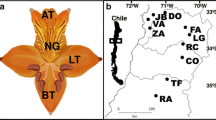Abstract
For a new, more complex floral form to become established in a population it must overcome the problem of frequency-dependent constancy to successfully attract pollinators. This may be achieved by complex floral forms offering absolute greater rewards than the simpler forms, or by complex flowers offering a higher probability of being rewarding because fewer pollinators are able to visit them. In this paper we examine the effect of three pollinator foraging strategies on the ratio of flights within and between floral morphs and hence on the probability of a new morph establishing in a population without offering a greater reward. We incorporate pollinator behaviour based around observations of two pollinator species systems into three models of competition for pollinators. In the first model the constancy of the pollinator of the new floral morph is a function only of the foraging strategy of the existing pollinator of the original floral morph. In the next model the constancy of the second pollinator is determined by the number of rewarding flowers of each floral morph left by the original pollinator and in the third model it is determined by the ratio of rewarding flowers of each morph left by the original pollinator. The results demonstrate that under conditions of intense competition for pollinators, new, more complex floral forms are indeed able to attract high levels of constant pollinators without offering intrinsically higher rewards. However, for this to occur constancy in one of the pollinators must be a function of the ratio of rewarding to non-rewarding flowers of both floral forms. One prediction from our results is that sympatric speciation of floral complexity based on a higher probability of reward is more likely to occur in flowers offering rewards of pollen rather than nectar. This is because the cost of visiting non-rewarding flowers is usually higher where the reward is pollen rather than nectar. We also predict that complex flowers occurring at low frequency, which offer rewards of nectar, may need intrinsically greater rewards if they are to successfully attract pollinators.
Similar content being viewed by others
References
Arroyo, J. and Dafni. A. (1995) Variation in habitat, scason, flower traits and pollinators in dimorphic Narcissus-tazetta L. (Amaryllidaceae) in Israel. New Phytol. 129, 135-145.
Brian, A.D. (1957) Differences in the flowers visited by four species of bumblebees and their causes. J. Anim. Ecol. 26, 71-98.
Brittain, W.H. and Newton, D.E. (1933) A study in the relative constancy of hive bees and wild bees in pollen gathering. Can. J. Res. 9, 334-349.
Darwin, C. (1862) The Various Contrivances by Which Orchids are Fertilised. Murray, London.
Graham, L. and Jones, K.N. (1996) Resource partitioning and per-flower foraging efficiency in two bumble bee species. Am. Midland Nat. 136, 401-406.
Grant, V. and Grant, K.A. (1965) Flower Pollination in the Phlox Family. Columbia University Press, New York.
Heinrick, B. (1975) Energetics of pollination. Ann. Rev. Ecol. Syst. 6, 139-170.
Levin, D.A. (1972) Low frequency disadvantage in the exploitation of pollinators by corolla variants in Phlox. The Am. Nat. 104, 455-467.
Levin, D.A. and Anderson, W.W. (1970) Competition for pollinators between simultaneously flowering species. The Am. Nat. 104, 455-467.
Mosquin, T. (1971) Competition for pollinators as a stimulus for evolution of flowering time. Oikos 22, 398-402.
Nei, M. (1975) Molecular Population Genetics and Evolution. North-Holland, Amsterdam.
Peleg, B. and Shmida, A. (1992) Short-run stable matchings between bees and flowers. Games Econ. Behav. 4, 232-251.
Proctor, M., Yeo, P. and Lack, A. (1996) The Natural History of Pollination. The New Naturalist, Harper Collins.
Rathcke, B. and Real, L. (1993) Autogamy and inbreeding depression in mountain laurel Kalmia latifolia (Ericaceae) Am. J. Bot. 80, 143-146.
Richards, A.J. (1997) Plant Breeding Systems. 2nd edn. Chapman & Hall, London.
Selten, R. and Shmida, A. (1991) Pollinator foraging and flower competition in a game equilibrium model. In: R. Selten (ed.) Game Equilibrium Models I: Evolution and Game Dynamics. Springer-Verlag, Berlin.
Stout, J.C., Allen, J.A. and Goulson, D. (1998) The influence of relative plant density and floral morphological complexity on the behaviour of bumblebees. Oecologia 117, 543-550.
Taylor, L.R. and Taylor, R.A.J. (1977) Aggregation migration and population mechanics. Nature 265, 415-421.
Vega-Redondo, F. (1996) Pollination and reward: a game-theoretic approach. Games and Econ. Behav. 12, 127-142.
Waser, N.M. and Price, M.V. (1981) Pollinator choice and stabilizing selection for flower color in Delphinium nelsonii. Evolution 35, 376-379.
Wright, S. (1931) Evolution in Mendelian populations. Genetics 16, 97-159.
Zahavi, A., Eisikowitch, D., Zahavi, A.K. and Cohen, A. (1983) A New Approach to Flower Constancy in Honey Bees. INRA (ed.) Vème Symposium International sur la Pollinisation. Versailles, 27–30 September 1983.
Author information
Authors and Affiliations
Rights and permissions
About this article
Cite this article
Warren, J., Diaz, A. A two-pollinator model for the evolution of floral complexity. Evolutionary Ecology 15, 157–166 (2001). https://doi.org/10.1023/A:1014826507699
Issue Date:
DOI: https://doi.org/10.1023/A:1014826507699




